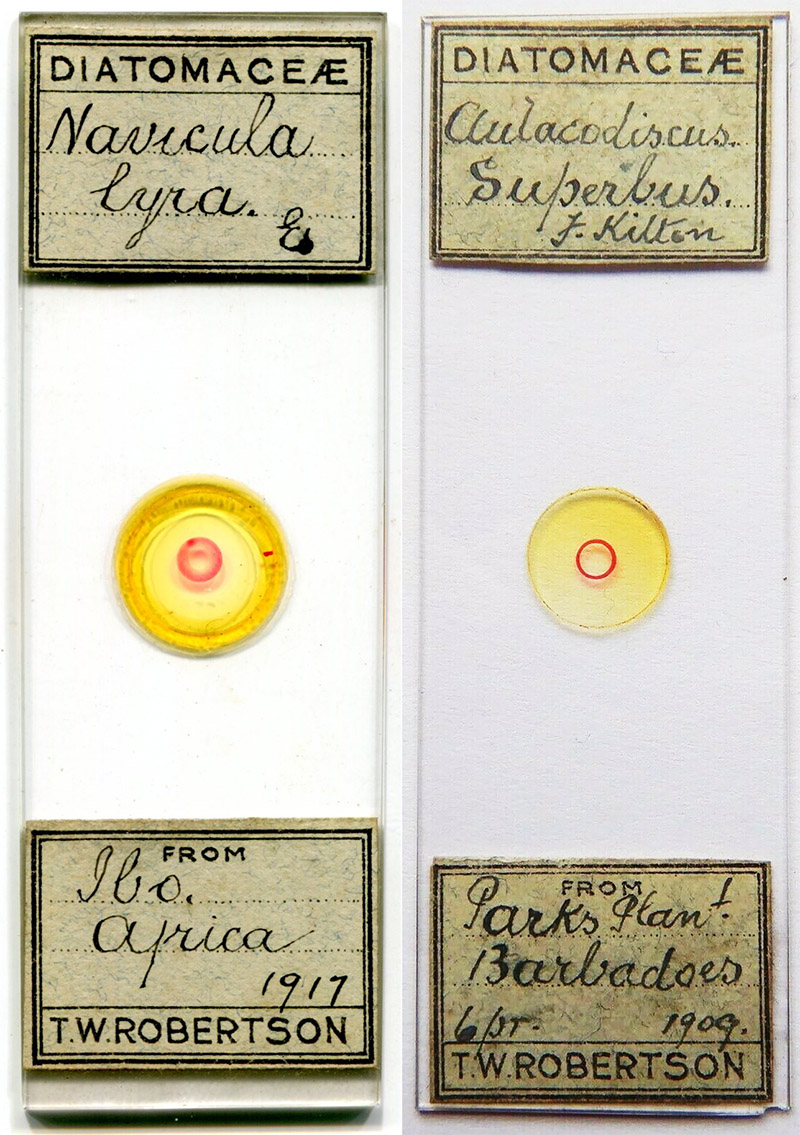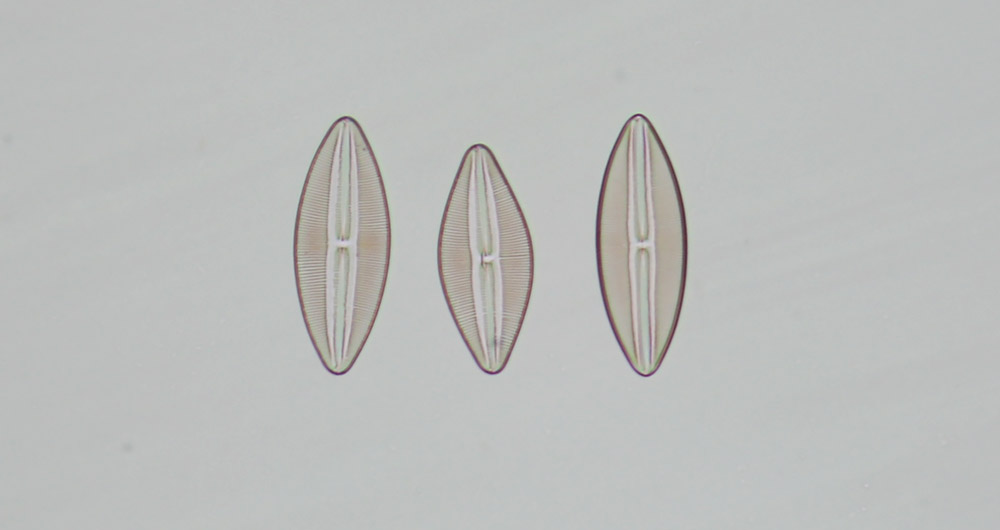
Figure 1. Two microscope slides of selected diatoms, prepared by T.W. Robertson in 1909 and 1917. Images from the author's collection or adapted for nonprofit, educational purposes from an internet auction site.
Thomas W. Robertson, 1869 – ca. 1940
by Brian Stevenson
last updated June, 2021
T.W. Robertson was a skilled amateur mounter, apparently specializing in diatoms (Figures 1 and 2). He was an heir to a steel business in Glasgow, Scotland. He joined the Natural History Society of Glasgow in 1898, and appears to have remained a member for several decades. The microscope slides illustrated in Figure 1 are dated 1909 and 1917.
A 1956 article in The Microscope included this comment: "Mr. Potter says that a man named Robertson of Glasgow, a steel master, was a very good amateur mounter; has anyone heard of him?" I am not aware of whether that query was answered previously, but the following essay describes what is currently known of Mr. Robertson.

Figure 1.
Two microscope slides of selected diatoms, prepared by T.W. Robertson in 1909 and 1917. Images from the author's collection or adapted for nonprofit, educational purposes from an internet auction site.

Figure 2.
Three Navicula lyra diatoms from "Ibo, Africa" (presumably Ibo Island, in northern Mozambique), prepared by T.W. Robertson. Photographed with a 10x objective lens and C-mounted digital SLR camera.
Thomas W. Robertson was born in Glasgow on February 24, 1869. He was evidently the eldest child of Matthew W. and Mary (née Mccoard) Robertson.
The father was owner of M.W. Robertson & Company, a steel processing and manufacturing business. Their Avon Steel Works on Glenpark Street, Glasgow was described thusly in 1891:
"Generally speaking, it may be said that the business carried on by Messrs. M.W. Robertson and Co., of the Avon Steel Works, Glasgow, is very similar in character to that carried on, by some of the most noted Sheffield firms. So far as Glasgow is concerned the Avon Steel Works may be regarded as almost unique, and they are more suggestive of South Yorkshire than of the iron industries of the Clyde. Originally the firm’s works were, for a time, at Linlithgow, but in 1869 the concern was centralised in Glasgow, which, of course, possesses advantages as a shipping, industrial, and distributive emporium. Messrs. Robertson and Co. in removing to a seaport may be said to have set an example for other firms, for there is a general tendency now-a-days to transfer works of a similar description to theirs from inland to shipping towns. Take for example Messrs. Charles Cammell and Co’s. Dronfield Works, which were removed to Workington, and the Dowlais Iron Works, the transference of which to Cardiff has been deemed expedient. The foresight of Messrs. Robertson and Co. was justified by the greater facilities and advantages they have since enjoyed in Glasgow, and their business has gradually expanded till now it occupies a foremost position. The works, which occupy an acre of ground, are well adapted to the various processes in operation and equipped with the best possible machinery, including large and small hammers, planing machines, drilling machines, etc.; also several powerful steam hammers for drawing and forging steel ingots into steel bars, afterwards used in the manufacture of tools. Particular attention is devoted to the manufacture of shear blades, which are made by this firm of the very largest size produced, namely, 14 1/2 feet long. The success they have achieved in this branch of their trade has greatly enhanced their prosperity. In addition to this speciality and the other operations already referred to they make to pattern crucible and cast steel castings and forgings of every description. The general processes carried on, therefore, are important and interesting, and the firm have come to be recognised as one of the most noteworthy engaged in the steel trade. Their connections are extensive and are not confined to the United Kingdom, but ramify to the British Colonies and to India."
On December 27, 1898, Thomas Robertson was elected to membership in the Natural History Society of Glasgow. At that time, he lived with his parents and younger siblings at 5 Whitehill Gardens, in the Dennistoun section of Glasgow.
The few known records on Robertson's microscopical pursuits all indicate an interest in diatoms and similar items.
The Transactions of the Natural History Society of Glasgow reported that on April 28, 1908, "Mr. Thomas W. Robertson exhibited a Glass-rope Sponge (Hyalonema Sieholdii, Gray), obtained off Tokio (sic), Japan, from a depth of over 300 fathoms, by means of a long line weighted and provided with hooks which were dragged along the sea-bottom. There was also shown under the microscope a slide containing several of the beautifully rayed silicious spicules of this species. … Mr. Robertson also submitted a beautiful collection of Diatoms prepared as microscope slides. These included specimens from New Zealand, Bolivia, California, and Madagascar, with some selected forms from a tin of American oysters". As an aside, canned oysters, sardines, and the like were commonly used as sources of diatom specimens.
In 1906, Robertson published this exchange request in Knowledge & Illustrated Scientific News, "Mr. T.W. Robertson, Glasgow, who is much interested in diatoms, would be grateful if any reader could assist him to get some diatomaceous deposit from the province of Simbirsk, Russia, and from Sendai, Japan. Mr. Robertson would be glad to defray any expense, or to know of anyone likely to supply his wants".
Robertson was also a photography enthusiast, and served various administrative roles in the Glasgow and West of Scotland Amateur Photographic Association.
By 1909, Thomas and his younger brother, William, had moved to Burnton, in the Mount Vernon area of Glasgow. City electoral records suggest that they may have moved together to Annette Street, Glasgow, around 1920.
The 1922 Who's Who in Engineering reported, "Robertson, M.W. & Co., Ltd., Arm Steel Works, 162, Glenpark Street, Glasgow. T.A. 'Shearsteel, Glasgow'. T.N.: Bridgeton 467 and 468. Established 1867. Incorporated 1908. Capital £4,000, Issued £3,450, Reserve £550. Directors M.W. Robertson, T.W. Robertson and W. Robertson. Employees: 50 to 60. Manufactures. - Case steel forgings and castings large shear blades".
Little more is known of T.W. Robertson's life. His business, M.W. Robertson & Co., was liquidated in 1944. Having been born in 1869, Thomas probably died at about that time.
Resources
The British Journal of Photography (1902) Glasgow and West of Scotland Amateur Photographic Association's Annual Exhibition, Vol. 48, page 74
Edinburgh Gazette (1944) M.W. Robertson & Company Limited (in liquidation), page 250
Glasgow and Its Environs (1891) Stratten & Stratten, London, page 198Glasgow Electoral Registers (1900) "Whitehill Gardens, 5, Thomas W. Robertson, Clerk", page 72, accessed through ancestry.com
Glasgow Electoral Registers (1923) "Annette Street, 43, Thomas W. Robertson, Robertson William L.", accessed through ancestry.com
Knowledge & Illustrated Scientific News (1906), Diatomaceous deposit, Vol. 29, page 465
Post Office Directory of Glasgow (1884) "Robertson, M.W. (of M.W. Robertson & Co.), ho. 5 Whitehill gardens, Dennistoun. … Robertson, M.W., & Co., steel converters and refiners, Avon Steel Works, Glenpark street"
Post Office Directory of Glasgow (1909) "Robertson, Thomas W., director (M.W. Robertson & Co., Ltd.); res. Burnton, North Mount Vernon", page 575
Scotland censuses and other records, accessed through ancestry.com
Transactions of the Natural History Society of Glasgow (1898) Minutes of the December 27 meeting, page 468
Transactions of the Natural History Society of Glasgow (1908) Minutes of the April 28 meeting, pages 300-301
Who's Who in Business (1914) "Robertson, M.W., & Co., Limited, Cast Steel Manufacturers, Forgers, Founders, and Shear-blade Makers, Avon Steel Works, 162, Glenpark Street, Glasgow. Hours of Business: 6 a.m. to 5.30 p.m. Established in 1867 by M.W. Robertson; joined by the late John Robertson and the late Thomas Robertson. Incorporated as a Limited Company in 1908. Directors: M.W. Robertson (Chairman), Thomas W. Robertson, William Robertson (Secretary). Specialities: Shear-blades up to 20 ft. long. Connection: United Kingdom, Colonial. Telephones: No. 2939 (National); No. 468 (Post Office), Bridgeton, Glasgow. Telegraphic Address: 'Shearsteel, Glasgow'. Bankers: British Linon Bank (Dennistoun, Glasgow", accessed through gracesguide.co.uk
Who's Who in Engineering (1922) "Robertson, M.W. & Co., Ltd., Arm Steel Works, 162, Glenpark Street, Glasgow. T.A. 'Shearsteel, Glasgow'. T.N.: Bridgeton 467 and 468. Established 1867. Incorporated 1908. Capital £4,000, Issued £3,450, Reserve £550. Directors M.W. Robertson, T.W. Robertson and W. Robertson. Employees: 50 to 60. Manufactures. - Case steel forgings and castings large shear blades", accessed through gracesguide.co.uk
The Yearbook of the Scientific and Learned Societies of Great Britain and Ireland (1901) Glasgow and West of Scotland Amateur Photographic Association, page 105